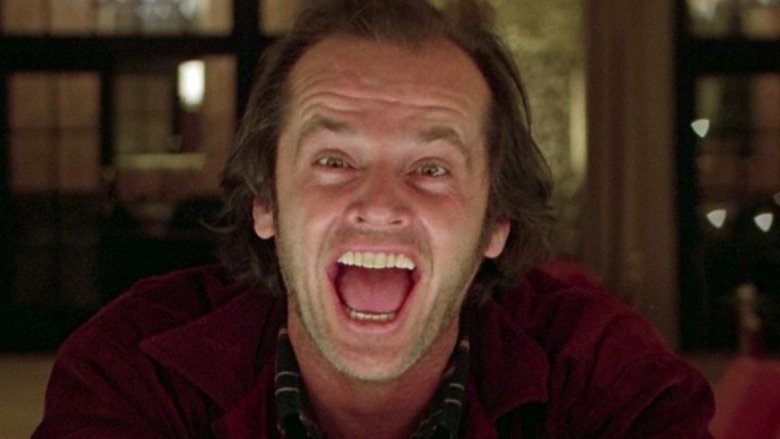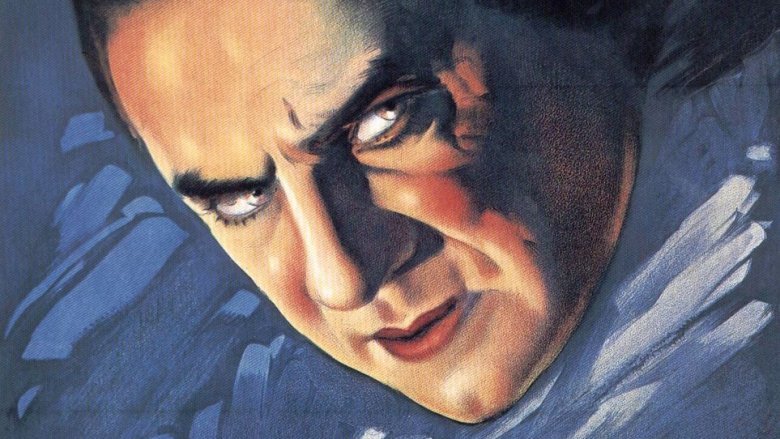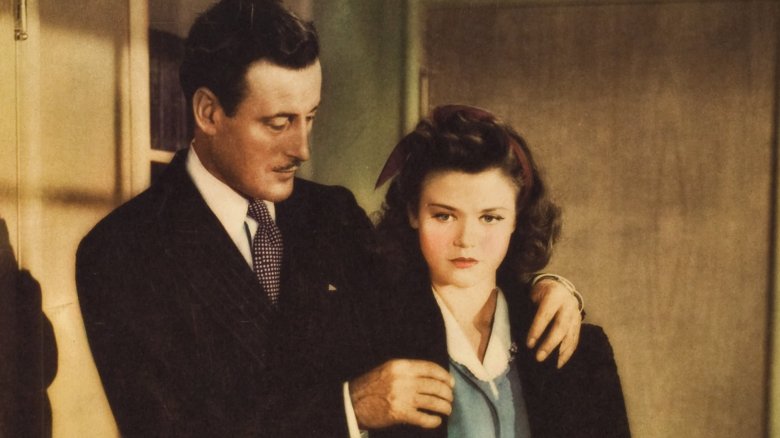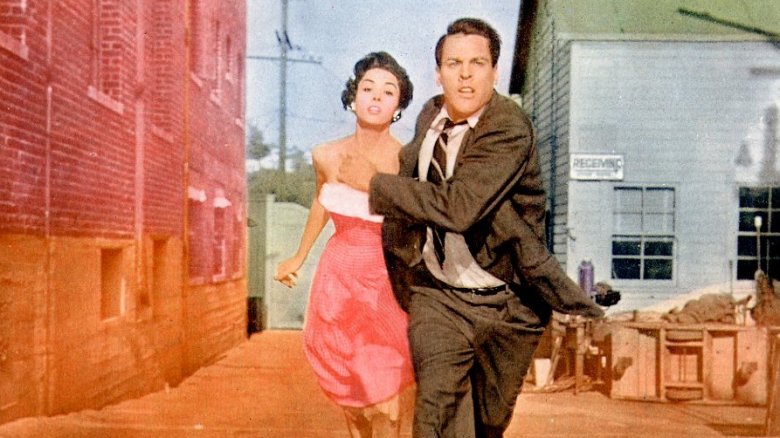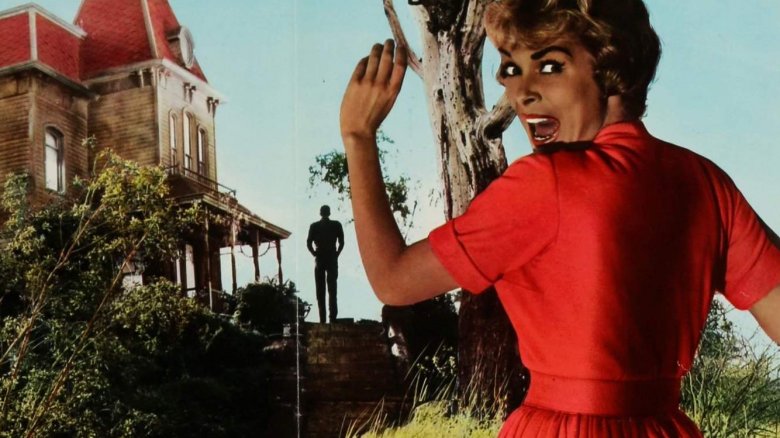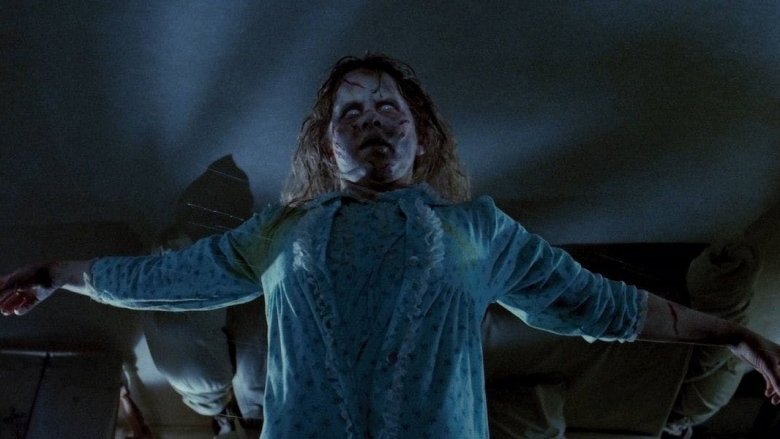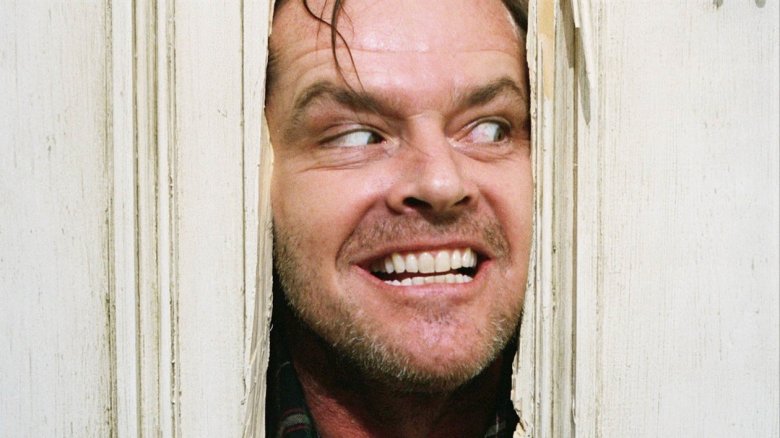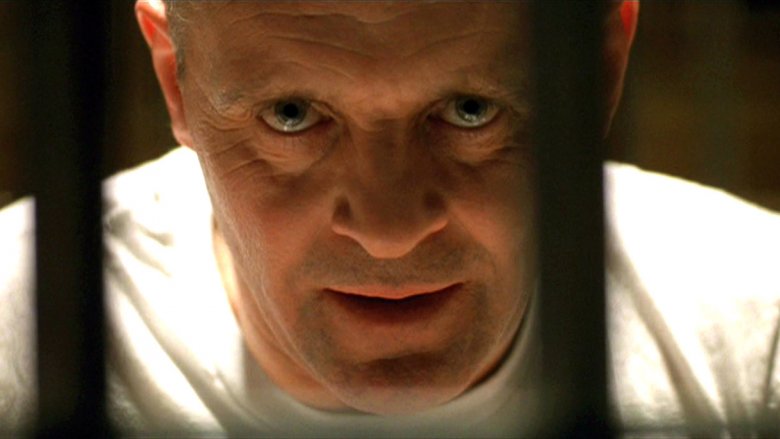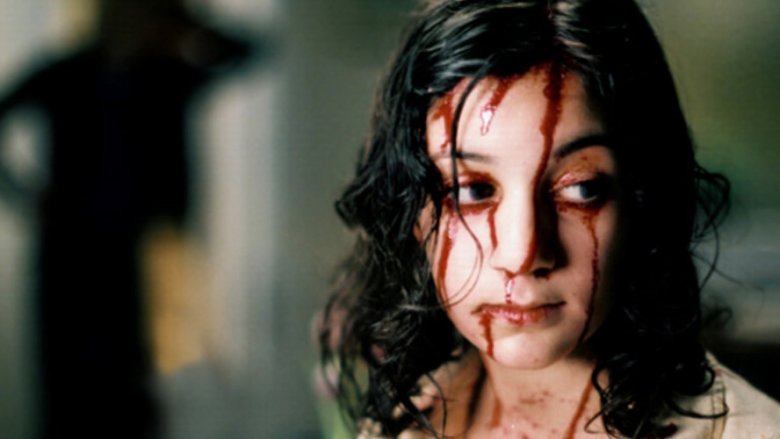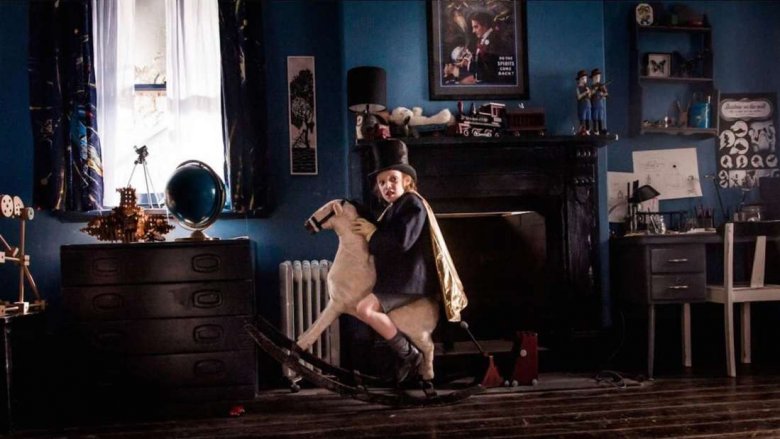The Best Horror Movie Of Every Decade
Ever since George Melies directed The Haunted Castle in 1896, the horror genre has been going strong. Sure, it's had some rough patches, but talented filmmakers from John Carpenter and Jordan Peele to Karyn Kusama and Jennifer Kent have always been able to find brilliant and bloody ways to tell scary stories.
But with so many amazing horror movies, how can you pick the best of the best? Well, if you get brutal, pull out your machete, and start hacking away, eventually each decade will have one film left standing — one that pushed boundaries, impacted pop culture, and was just plain awesome. For example, the 1920s was a spectacular decade that featured films like The Phantom of the Opera and The Cabinet of Dr. Caligari, but Nosferatu sucks them both dry when it comes to being the greatest film of the silent film era.
But what about after that? Which horror movies stand out from the 1930s to the 2010s? Which scream queens and slasher villains, monsters and madmen have stood the test of time? From vampire tales to possession stories, these are the best horror movies of every decade.
The 1930s had an undead icon
The 1930s were a golden age for horror movies. King Kong revolutionized special effects, Freaks was so shocking that it allegedly caused a miscarriage, and Island of Lost Souls sparked outrage with its vivisection scene. But if you're talking about 1930s horror, you've got to pay homage to Universal Studios. The company was at the height of its scary powers, releasing classics like Frankenstein, The Mummy, Bride of Frankenstein, and The Invisible Man. But there's one iconic creature who looms above them all: a caped count by the name of Dracula.
Released in 1931, Dracula wasn't the first vampire movie. It wasn't even the first movie inspired by Bram Stoker's novel. But it did establish the undead ideal, all thanks to Bela Lugosi. With his hypnotic hands and Hungarian accent, Lugosi set the mold for every vampire film to come, and every line he delivers is both creepy and charming, aristocratic and eerie. When he talks about the "children of the night," there's an evil glee in his eyes that few vampire actors have ever recaptured.
In addition to Lugosi's bloodcurdling performance, Karl Freund's haunting cinematography coupled with the Gothic sets — a massive staircase and gigantic spiderwebs, all shrouded in fog — provide an incredibly ominous atmosphere. And while it wasn't the first horror talkie, sound was still pretty new, so audiences were caught in the spell of Dracula's Transylvanian drawl, and they cowered when they heard the creaky doors of his castle swing open. Thanks to this seductive bloodsucker, horror became one of Hollywood's most popular genres.
The 1940s had a creepy cat curse
The 1940s were a little lacking when it comes to classic horror films. Sure, you've got The Wolf Man and Abbott and Costello Meet Frankenstein (a favorite of Quentin Tarantino), but it's a mixed bag after that. Maybe audiences weren't interested in scary movies with so much horror happening in real life. Or maybe filmmakers felt they couldn't live up to RKO's Cat People.
Produced by Val Lewton and directed by Jacques Tourneur, Cat People follows a young woman named Irene (Simone Simon) who's got a bit of trouble in the intimacy department. She's worried about getting it on with her new husband (Oliver Reed) because she thinks if she gets aroused, she'll turn into a black panther and rip his head off. It's a pretty strong case for abstinence, although we're not sure if Irene is just troubled or if there's actually some evil magic running through her family tree.
And that's why Cat People is such a masterpiece. It plays on the fear of the unknown by keeping the killer cat-woman offscreen. In the film's most famous sequence, a woman (Jane Randolph) is walking down a deserted street late at night. She's got a sneaking suspicion that something inhuman is behind her. The tension finally breaks when a bus comes roaring up next to her, terrifying the audience and introducing the jump scare. Later on, the same woman finds herself trapped in a swimming pool, stalked by something growling in the darkness. We only see its shadow, only hear its roar, and that mystery lets the imagination go wild.
The 1950s had paranoia and pod people
Everybody was afraid in the 1950s. You wouldn't know it by watching Leave It to Beaver, but this was a decade defined by fear. And that constant feeling of being afraid had a major impact on filmmakers. People were scared of nuclear weapons, so we got movies like Godzilla. People were freaked out by science gone awry, so we got The Fly. And every American thought there was a communist in their closet, so we got Invasion of the Body Snatchers, the cinematic embodiment of pure paranoia.
Directed by Don Siegel (who would later direct Dirty Harry), this 1956 film takes place in a quiet California town. Dr. Miles Bennell (Kevin McCarthy) is a clean-cut doctor living in a wholesome American neighborhood, but there's a sinister force invading Everytown, USA. The good doctor soon realizes that all his friends are being replaced by alien doppelgängers who look and sound exactly like people, only they lack any human emotions. They're cold, calculating, and plan on taking over the world, using plant pods that grow clones to replace human beings.
Sure, the idea of pod people might sound a little corny, and some of the effects are a bit hokey, but the movie is still effective because it's completely soaked in suspicion and dread. Dr. Miles knows the pod people are coming, but nobody will listen. He thinks he can trust his friends, but what if they're actually impostors? And the idea of being replaced — consumed and changed by some malevolent force — is truly chilling. Long before The Wicker Man or The Thing, Body Snatchers proved that paranoia was an incredibly effective scare tactic.
The 1960s had a truly scary shower
The 1960s wasn't just love and hippies. The decade was a dark one — JFK and Martin Luther King were assassinated, Vietnam was getting started, and free love gave way to Charles Manson. Things were changing fast, and it didn't always end well. So filmmakers dipped into that well of fear and created masterpieces like Night of the Living Dead and Rosemary's Baby. There was a creeping sense of dread in all these films, a fear of something sick and twisted lurking in society's shadows, and if you want to talk about sick and twisted, you've got to talk about Psycho.
Directed by Alfred Hitchcock, Psycho was a game-changing film that's buried its way deep into the pop culture consciousness. Try making any sort of stabbing motion without someone going, "Eek, eek, eek!" Bernard Herrmann's violent score is just as iconic as Anthony Perkins' performance as the quietly creepy Norman Bates. He's both sympathetic and psychotic, and that infamous shower scene is one of the scariest horror moments of all time. Sure, it's been parodied to death, but in 1960, it was an absolute shock. There was Janet Leigh, the main character, dead on the bathroom floor. That's not how movies are supposed to work. The hero isn't supposed to die midway through the film. But Psycho didn't care about the rules.
And neither did Hitchcock, who battled the censors to create a truly shocking movie that pushed the boundaries of sex and violence in mainstream movies. And with that brutal knife attack, Psycho became the granddaddy of the slasher genre. No Norman Bates, and there's no Michael Myers, Freddy Krueger, or Leatherface. And while it's not as bloody as modern horror, Psycho is still an unsettling film that will make you think twice about stepping in a hotel shower. Because unlike most movie monsters, Norman Bates could really exist — and as Psycho showed the world, he could be hiding anywhere.
The 1970s had a demonic little girl
With Munich, Nixon, and Vietnam, the 1970s was a pretty dark decade. And as the world descended into chaos and doubt, the Hollywood studio system completely collapsed, giving rise to bold new directors who made edgy films for young audiences. As a result, the 1970s gave us gory gems like Jaws, The Texas Chainsaw Massacre, Carrie, and Halloween. That's not even mentioning Alien, The Omen, and Don't Look Now.
However, there's one '70s horror classic that's far more demonic than any of its peers, one so iconic that it's become the standard for every scary movie ever since: William Friedkin's The Exorcist. Nearly 50 years later, we've seen this possession story a million times, so it might be hard for modern audiences to appreciate The Exorcist as the world-shattering, nausea-inducing game-changer that it was. But this little movie left people shook. Theaters provided barf bags and had smelling salts for people who fainted. But despite the fear and furor, it became a pre-blockbuster blockbuster and one of the few horror films ever nominated for Best Picture.
At the time, the special effects were out of this world, and audiences were repelled by the puking and the head-twisting. Watching a little girl (an amazing Linda Blair) blaspheme and do nasty things with a crucifix made even the biggest horror buffs lose their lunch. But under all the slimy green goo, this movie works so well because it's got such a big heart. There's a mother fighting for her daughter's life, a priest struggling with guilt and faith, and a child begging for salvation. The acting is Oscar-worthy, and the final confrontation between good and evil still resonates.
The 1980s had Jack with an ax
During the 1980s, everything was big — from hairstyles to music videos — and that included horror movies. The genre became a blockbuster staple, with hits like Poltergeist and Aliens. Ghostbusters and Gremlins were two of the highest-grossing films of the decade. And auteurs like John Carpenter and David Cronenberg explored the boundaries of body horror with classics like The Thing and The Fly. But when it comes to horror movie greatness, it doesn't get any more perfect than The Shining.
Directed by the legendary Stanley Kubrick, The Shining is big, cold, labyrinth of a movie. It's meticulous, ambiguous, and so enigmatic there's an entire documentary about elaborate Shining fan theories. After all, this is a movie ripe for analysis. What's up with the guy in the dog suit? What's the significance of Room 237? And what's going on with that chilling final shot? These mysteries linger on nearly 40 years later, but The Shining is far more than just an unsolvable maze with axe-wielding maniac at the center of it all.
Kubrick's use of the steadicam — following little Danny Torrance around the Overlook — is groundbreaking, and both Jack Nicholson and Shelley Duvall give heightened Gothic performances that perfectly match the overwhelming presence of the hotel. And the Overlook is one of cinema's great haunted houses, one that's home to some of horror's greatest scares: the eerie Grady twins lurking in the hallway, an elevator gushing with gallons of blood, and Nicholson sticking his head through a bathroom door. The Shining is a nightmare that never stops, and just like a bad dream, we'll be trying to decipher its meaning for years to come.
The 1990s had a sophisticated cannibal
The 1990s is widely considered a pretty lame decade for horror, but a few diabolical diamonds stand out from the dreck. Scream reinvigorated the slasher genre by making things meta, The Blair Witch Project ushered in a new era of indie filmmaking, and The Sixth Sense stunned audiences with perhaps the greatest movie twist of all time. But while we doff our hats to the likes of Ghostface and Candyman, Hannibal Lecter was the ultimate '90s bogeyman.
The Silence of the Lambs is the only horror movie so far to win the Best Picture Oscar, and it also picked up gold trophies for Actor, Actress, Director, and Screenplay. Based on the novel by Thomas Harris, this 1991 thriller dives deep into Gothic territory. Hannibal lives in a cell straight out of a Hammer film. Buffalo Bill's dungeon looks like it was designed by Vincent Price. Yeah, these guys are based on real serial killers, but they exist in a world slightly outside our own, where cannibals drink chianti and kill their victims to classical music.
While the movie is anchored by Jodie Foster's tough-as-nails performance as Clarice Starling, its legend has lasted so long thanks to Anthony Hopkins, who created one of the greatest movie monsters of all time. His twisted psychologist belongs up there with Dracula, Jack Torrance, and Freddy Krueger, and there's no doubt he could outsmart them all. Calm, creepy, and charismatic, he can discuss literature one minute, devour your liver the next. He's a creature who exists in both bedtime stories and the real world, and The Silence of the Lambs will stick around for years thanks to his eternal evil.
The 2000s had a twisted vampire romance
The vampire tale is as old as time, but the creature's popularity had a massive resurgence in 2008. That was when Twilight hit theaters, but that teen love story wasn't the only undead romance in cinemas that year. Directed by Tomas Alfredson, Let the Right One In was also released in 2008, and it's a twisted story of love, loneliness, and murder. It's also the greatest horror film of the 2000s, a decade full of modern-day classics like The Mist, The Others, and 28 Days Later.
Set in a desolate Stockholm, Let the Right One In follows a 12-year-old boy named Oskar (Kåre Hedebrant) who befriends a seemingly young girl named Eli (Lina Leandersson). Both look so innocent, but they harbor disturbing secrets. Oskar is regularly bullied at school and spends his nights, knife in hand, plotting gruesome revenge. And Eli is a centuries-old vampire who drinks the life force of human beings. Soon enough, these two little monsters connect with one another, but is this a case of lost souls finding solace together, or is it a toxic relationship with grim implications? Can it be both?
Bleak and snowy on the surface, the movie's heart is bloody and red. Let the Right One In views Eli and Oskar as killers through and through, and it makes us queasy to watch their crimes. But much like the work of Guillermo del Toro, Alfredson and screenwriter John Ajvide Lindqvist (who also wrote the novel the film is based on) sympathize with the two leads as lonely beasts, hurt by so many people. It isn't easy being a monster, and Let the Right One In takes a look at these creatures in all their messy, murderous complexity.
The 2010s had a grieving mother and a grinning ghoul
Anyone who says "they don't make movies like they used to" isn't paying attention. The 2010s hasn't just been a great decade for horror. It might be the best decade for horror. Seriously, check out this lineup: Get Out, It Follows, The Conjuring, Hereditary, It, The Witch, You're Next, Kill List, and A Quiet Place. Need we go on? Okay, we will. You've also got Insidious, The Cabin in the Woods, Split, The Wailing, Under the Skin, and The Purge series. We could keep listing movie after incredible movie, which means it's kind of hard to pick the very best. But when it comes down to it, whether it's in a word or it's in a look, you've got to go with The Babadook.
Directed by Jennifer Kent, this Australian horror film deals with one of the most serious and studied topics in all of horror: grief. Movies like Don't Look Now and Mandy have explored this devastating emotion, but none have gone into the depths of depression and despair quite like The Babadook. Whether the titular top-hat wearing demon is real, metaphorical, or a weird combo of both, he's one of the most powerful symbols of death and anguish in cinema history. Then there's Essie Davis, whose performance as a mother on the verge of collapse is both heartbreaking and horrific. And even looking past the symbolism, The Babadook is just straight-up terrifying. Everything here drips with dread, from that creepy pop-up book to Noah Wiseman's devilish performance as a troubled little kid. In a decade filled with remarkable films, it's The Babadook that will haunt horror fans for years to come.
